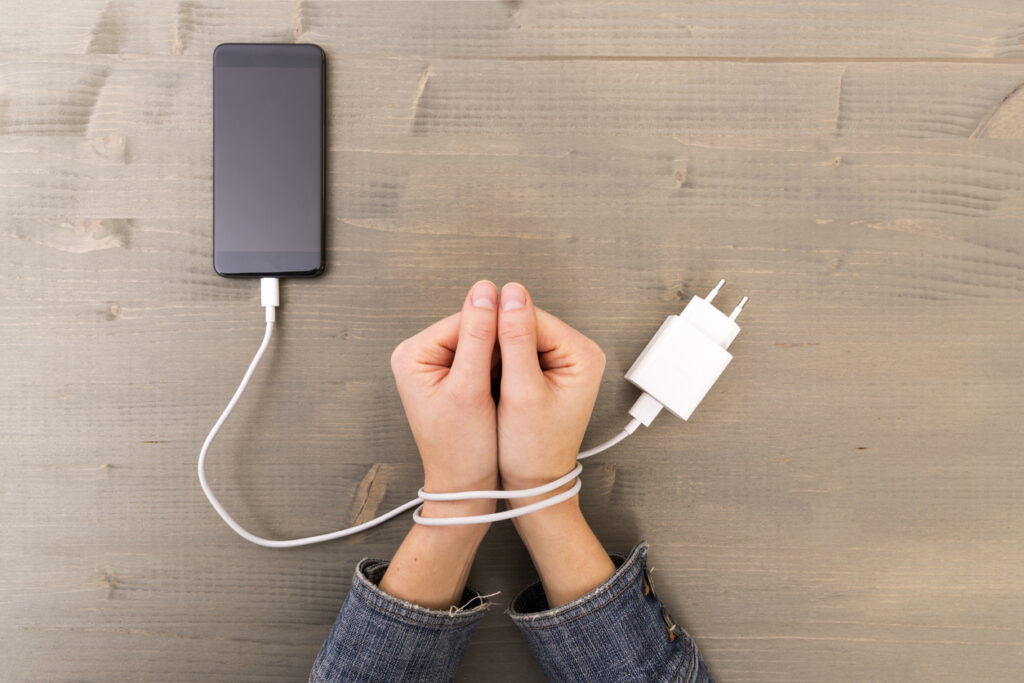Our ‘always on’ digital culture is having a negative effect on our mental health. It’s time to switch off. Here are three top tips to help you detach from that smartphone and start living in the real world again.
Most of us use technology every day at work, at home and on the move. Modern technology means that we are always connected to work, friends, connections and family.
This makes it easy for us to become a slave to the various apps, email and messaging platforms.
We worry about what perception others will have of us if we are not connected and commenting, liking or answering emails. Will we be seen as ‘not being committed’ (to work) or will friends and family think we don’t care’?
This can lead to us spending time we don’t want to and time we don’t have tapping away on our devices in the hope of keeping everyone happy and in a positive mind set about us.
This in itself has a negative impact on our mental health and wellbeing – we’re constantly worrying about what everyone is thinking, not sleeping because we can’t put our device down or have spent so much time in front of a screen before bed that we cant switch off and are lying there in the dark with our minds buzzing.
The good news is that there are things you can do to combat this. Here, we’ll share three tips on maintaining a healthy use of technology in our work and personal lives.
1. Explain what you are doing
Tell your friends and family what you are doing and why – that way, they may not like it, but they will know why you haven’t instantly responded to their message, post or email.
At work, don’t be afraid to put your out of office on saying you are looking at email periodically throughout the day.
Work during your work time and switch it off after work – you are not employed to be available on screen 24/7.
This will manage expectations of getting an immediate response. Then schedule email time in your working day so that you are not distracted (or indeed procrastinate) about the other work you need to do.
Also ask to only be copied in where it is necessary rather than just for info – it will cut down the unnecessary emails that clog your account and give you that awful sinking feeling when you open your inbox.
Benefits: this will improve your time management and stop you being distracted with thoughts and worries about responding and what people may be thinking about you.
2. Commit to screen-free time
Reduce screen time around the end of the day – give at least an hour before bedtime to allow your mind to switch off for the night.
Set aside time for screens and time to do other things like relaxation, exercise, or hobbies that don’t need a screen.
Have family (and friends) screen-free time together. Reinvent how you enjoy time together – play traditional games, go for a walk, visit a park, play outdoor games, read, craft, colour – the options without screens are endless and can be great fun.
Benefits: you get to switch off from work and focus on the other aspects of your life including yourself – that bubble bath with a glass of wine can be greatly improved if your reduce screen time around the end of the day.
3. Manage your working day better
Turn off/restrict notifications on your devices.
Work during your work time and switch it off after work – you are not employed to be available on screen 24/7. Turn your work email off your personal mobile or just turn the notifications off. Turn your work mobile off when you get home and back on when you get to work the next day.
If the person you need to talk to is in the same building as you, don’t just email them back, go and find them and talk face to face – you might even have a coffee together. This will break up your screen time, get you moving and helps avoid misunderstandings that happen over quick emailed responses. You will feel much better for it.
It’s not rocket science but it does take a little bravery. Remember that technology is there to be a helpful tool to us – not to enslave us!
Schedule email time in your working day so that you are not distracted (or indeed using it to procrastinate) about the other work you need to do.
Have screen-free meetings at work where you just focus on the meeting and the people in the room and pick up your devices afterwards. There’s nothing worse than seeing someone tapping away on their device under the table (or on it) when they should be contributing to the meeting, they are in.
Create screen-free areas – this can work in the workplace as well as at home. Most of us work with a computer on our desk and then sit in the staff room looking at the screen of our phone or tablet.
HSE advises regular breaks from screen time every 20 – 30 minutes, so give yourself another break at lunchtime.
Move away from your desk to eat and leave your email behind and give yourself a break from all screens for at least part of your break if you can’t manage it for the whole break time.
Benefits: increased control and better time management, meaning you have less of a need to work after hours or through your lunch break or even at the weekend. You will also have less fatigue during the day by taken proper screen breaks and eating and having some fresh air and gentle activity at lunchtime. It is well researched that those who take a proper break at lunchtime are significantly more productive in the afternoon, make better decisions and have better interactions with their colleagues and customers.
[cm_form form_id=’cm_65a14c3f5da64′]
Summary
It’s not rocket science but it does take a little bravery. Remember that technology is there to be a helpful tool to us – not to enslave us!
Use technology so that it has a positive impact on your life and health, but don’t let it take over.
Now… who’s been contacting me whilst I’ve been writing this article?!
Interested in this topic? Read Digital wellbeing: caring for employees in an ‘always on’ culture.






